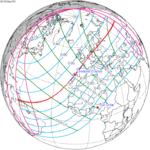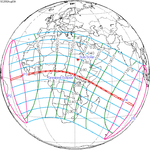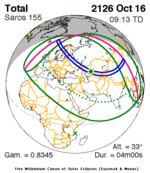Loading AI tools
Total eclipse From Wikipedia, the free encyclopedia
A total solar eclipse occurred at the Moon's ascending node of orbit on Monday, April 28, 1930,[1] with a magnitude of 1.0003. It was a hybrid event, with only a fraction of its path as total, and longer sections at the start and end as an annular eclipse. A solar eclipse occurs when the Moon passes between Earth and the Sun, thereby totally or partly obscuring the image of the Sun for a viewer on Earth. A total solar eclipse occurs when the Moon's apparent diameter is larger than the Sun's, blocking all direct sunlight, turning day into darkness. Totality occurs in a narrow path across Earth's surface, with the partial solar eclipse visible over a surrounding region thousands of kilometres wide. The Moon's apparent diameter was near the average diameter because it occurred 7.2 days after apogee (on April 21, 1930, at 13:50 UTC) and 6 days before perigee (on May 4, 1930, at 19:50 UTC).[2]
Annularity was first visible in the eastern Pacific Ocean, then totality from California, Nevada, Oregon, Idaho and Montana, with annularity continuing northeast across the remainder of Montana and into central and eastern Canada and northern Labrador of the Dominion of Newfoundland (today's Newfoundland and Labrador in Canada). A partial eclipse was visible for parts of Hawaii, North America, and the northern Soviet Union.
During a hybrid solar eclipse, the apex of the moon's umbral cone was very close to the Earth's surface, and the magnitude was very large. The edges of the moon and the sun were very close to each other as seen from the Earth in both the total and annular portion of the path. A series of Baily's beads on the lunar limb provided an excellent opportunity to measure the size and shape of the Earth, as well as the mountains and valleys on the lunar limb. Scientists recorded the precise time of each phase of the eclipse in Camptonville, California. Because the duration of totality was just more than 1 second, the photographic film needed to be inserted quickly after the start of totality. In addition, scientists recorded audio images with a long-wave receiver on an aircraft at the Mare Island Naval Shipyard. Each image had a time accurate to 1/5 second.
Prior to it, the hybrid solar eclipse of April 17, 1912, also belonging to Solar Saros 137, also occurred with a magnitude close to 1. Observations were made near Paris, France. Similar observations were also made during the annular solar eclipses of May 9, 1948 in Rebun Island, Japan and May 20, 1966 in Greece and Turkey, also belonging to the same solar Saros cycle.[3]
Shown below are two tables displaying details about this particular solar eclipse. The first table outlines times at which the moon's penumbra or umbra attains the specific parameter, and the second table describes various other parameters pertaining to this eclipse.[4]
| Event | Time (UTC) |
|---|---|
| First Penumbral External Contact | 1930 April 28 at 16:20:27.5 UTC |
| First Umbral External Contact | 1930 April 28 at 17:25:43.5 UTC |
| First Central Line | 1930 April 28 at 17:26:14.8 UTC |
| Greatest Duration | 1930 April 28 at 17:26:14.8 UTC |
| First Umbral Internal Contact | 1930 April 28 at 17:26:46.1 UTC |
| Greatest Eclipse | 1930 April 28 at 19:03:34.0 UTC |
| Ecliptic Conjunction | 1930 April 28 at 19:08:43.9 UTC |
| Equatorial Conjunction | 1930 April 28 at 19:27:27.4 UTC |
| Last Umbral Internal Contact | 1930 April 28 at 20:40:09.2 UTC |
| Last Central Line | 1930 April 28 at 20:40:37.6 UTC |
| Last Umbral External Contact | 1930 April 28 at 20:41:06.0 UTC |
| Last Penumbral External Contact | 1930 April 28 at 21:46:24.5 UTC |
| Parameter | Value |
|---|---|
| Eclipse Magnitude | 1.00026 |
| Eclipse Obscuration | 1.00053 |
| Gamma | 0.47305 |
| Sun Right Ascension | 02h21m32.7s |
| Sun Declination | +14°06'03.1" |
| Sun Semi-Diameter | 15'52.8" |
| Sun Equatorial Horizontal Parallax | 08.7" |
| Moon Right Ascension | 02h20m46.1s |
| Moon Declination | +14°30'42.8" |
| Moon Semi-Diameter | 15'39.8" |
| Moon Equatorial Horizontal Parallax | 0°57'29.0" |
| ΔT | 24.0 s |
This eclipse is part of an eclipse season, a period, roughly every six months, when eclipses occur. Only two (or occasionally three) eclipse seasons occur each year, and each season lasts about 35 days and repeats just short of six months (173 days) later; thus two full eclipse seasons always occur each year. Either two or three eclipses happen each eclipse season. In the sequence below, each eclipse is separated by a fortnight.
| April 13 Descending node (full moon) | April 28 Ascending node (new moon) |
|---|---|
 |  |
| Partial lunar eclipse Lunar Saros 111 | Hybrid solar eclipse Solar Saros 137 |
This eclipse is a member of a semester series. An eclipse in a semester series of solar eclipses repeats approximately every 177 days and 4 hours (a semester) at alternating nodes of the Moon's orbit.[5]
The partial solar eclipse on June 17, 1928 occurs in the previous lunar year eclipse set, and the partial solar eclipse on September 12, 1931 occurs in the next lunar year eclipse set.
| Solar eclipse series sets from 1928 to 1931 | ||||||
|---|---|---|---|---|---|---|
| Ascending node | Descending node | |||||
| Saros | Map | Gamma | Saros | Map | Gamma | |
| 117 | May 19, 1928 Total (non-central) |
1.0048 | 122 | November 12, 1928 Partial |
1.0861 | |
| 127 | May 9, 1929 Total |
−0.2887 | 132 | November 1, 1929 Annular |
0.3514 | |
| 137 | April 28, 1930 Hybrid |
0.473 | 142 | October 21, 1930 Total |
−0.3804 | |
| 147 | April 18, 1931 Partial |
1.2643 | 152 | October 11, 1931 Partial |
−1.0607 | |
This eclipse is a part of Saros series 137, repeating every 18 years, 11 days, and containing 70 events. The series started with a partial solar eclipse on May 25, 1389. It contains total eclipses from August 20, 1533 through December 6, 1695; the first set of hybrid eclipses from December 17, 1713 through February 11, 1804; the first set of annular eclipses from February 21, 1822 through March 25, 1876; the second set of hybrid eclipses from April 6, 1894 through April 28, 1930; and the second set of annular eclipses from May 9, 1948 through April 13, 2507. The series ends at member 70 as a partial eclipse on June 28, 2633. Its eclipses are tabulated in three columns; every third eclipse in the same column is one exeligmos apart, so they all cast shadows over approximately the same parts of the Earth.
The longest duration of totality was produced by member 11 at 2 minutes, 55 seconds on September 10, 1569, and the longest duration of annularity will be produced by member 59 at 7 minutes, 5 seconds on February 28, 2435. All eclipses in this series occur at the Moon’s ascending node of orbit.[6]
| Series members 24–46 occur between 1801 and 2200: | ||
|---|---|---|
| 24 | 25 | 26 |
 February 11, 1804 |
 February 21, 1822 |
 March 4, 1840 |
| 27 | 28 | 29 |
 March 15, 1858 |
 March 25, 1876 |
 April 6, 1894 |
| 30 | 31 | 32 |
 April 17, 1912 |
 April 28, 1930 |
 May 9, 1948 |
| 33 | 34 | 35 |
 May 20, 1966 |
 May 30, 1984 |
 June 10, 2002 |
| 36 | 37 | 38 |
 June 21, 2020 |
 July 2, 2038 |
 July 12, 2056 |
| 39 | 40 | 41 |
 July 24, 2074 |
 August 3, 2092 |
 August 15, 2110 |
| 42 | 43 | 44 |
 August 25, 2128 |
 September 6, 2146 |
 September 16, 2164 |
| 45 | 46 | |
 September 27, 2182 |
 October 9, 2200 | |
The metonic series repeats eclipses every 19 years (6939.69 days), lasting about 5 cycles. Eclipses occur in nearly the same calendar date. In addition, the octon subseries repeats 1/5 of that or every 3.8 years (1387.94 days). All eclipses in this table occur at the Moon's ascending node.
| 22 eclipse events between December 2, 1880 and July 9, 1964 | ||||
|---|---|---|---|---|
| December 2–3 | September 20–21 | July 9–10 | April 26–28 | February 13–14 |
| 111 | 113 | 115 | 117 | 119 |
 December 2, 1880 |
 July 9, 1888 |
 April 26, 1892 |
 February 13, 1896 | |
| 121 | 123 | 125 | 127 | 129 |
 December 3, 1899 |
 September 21, 1903 |
 July 10, 1907 |
 April 28, 1911 |
 February 14, 1915 |
| 131 | 133 | 135 | 137 | 139 |
 December 3, 1918 |
 September 21, 1922 |
 July 9, 1926 |
 April 28, 1930 |
 February 14, 1934 |
| 141 | 143 | 145 | 147 | 149 |
 December 2, 1937 |
 September 21, 1941 |
 July 9, 1945 |
 April 28, 1949 |
 February 14, 1953 |
| 151 | 153 | 155 | ||
 December 2, 1956 |
 September 20, 1960 |
 July 9, 1964 | ||
This eclipse is a part of a tritos cycle, repeating at alternating nodes every 135 synodic months (≈ 3986.63 days, or 11 years minus 1 month). Their appearance and longitude are irregular due to a lack of synchronization with the anomalistic month (period of perigee), but groupings of 3 tritos cycles (≈ 33 years minus 3 months) come close (≈ 434.044 anomalistic months), so eclipses are similar in these groupings.
| Series members between 1801 and 2200 | ||||
|---|---|---|---|---|
 April 4, 1810 (Saros 126) |
 March 4, 1821 (Saros 127) |
 February 1, 1832 (Saros 128) |
 December 31, 1842 (Saros 129) |
 November 30, 1853 (Saros 130) |
 October 30, 1864 (Saros 131) |
 September 29, 1875 (Saros 132) |
 August 29, 1886 (Saros 133) |
 July 29, 1897 (Saros 134) |
 June 28, 1908 (Saros 135) |
 May 29, 1919 (Saros 136) |
 April 28, 1930 (Saros 137) |
 March 27, 1941 (Saros 138) |
 February 25, 1952 (Saros 139) |
 January 25, 1963 (Saros 140) |
 December 24, 1973 (Saros 141) |
 November 22, 1984 (Saros 142) |
 October 24, 1995 (Saros 143) |
 September 22, 2006 (Saros 144) |
 August 21, 2017 (Saros 145) |
 July 22, 2028 (Saros 146) |
 June 21, 2039 (Saros 147) |
 May 20, 2050 (Saros 148) |
 April 20, 2061 (Saros 149) |
 March 19, 2072 (Saros 150) |
 February 16, 2083 (Saros 151) |
 January 16, 2094 (Saros 152) |
 December 17, 2104 (Saros 153) |
 November 16, 2115 (Saros 154) |
 October 16, 2126 (Saros 155) |
 September 15, 2137 (Saros 156) |
 August 14, 2148 (Saros 157) |
 July 15, 2159 (Saros 158) |
 June 14, 2170 (Saros 159) |
 May 13, 2181 (Saros 160) |
 April 12, 2192 (Saros 161) | ||||
This eclipse is a part of the long period inex cycle, repeating at alternating nodes, every 358 synodic months (≈ 10,571.95 days, or 29 years minus 20 days). Their appearance and longitude are irregular due to a lack of synchronization with the anomalistic month (period of perigee). However, groupings of 3 inex cycles (≈ 87 years minus 2 months) comes close (≈ 1,151.02 anomalistic months), so eclipses are similar in these groupings.
| Series members between 1801 and 2200 | ||
|---|---|---|
 July 17, 1814 (Saros 133) |
 June 27, 1843 (Saros 134) |
 June 6, 1872 (Saros 135) |
 May 18, 1901 (Saros 136) |
 April 28, 1930 (Saros 137) |
 April 8, 1959 (Saros 138) |
 March 18, 1988 (Saros 139) |
 February 26, 2017 (Saros 140) |
 February 5, 2046 (Saros 141) |
 January 16, 2075 (Saros 142) |
 December 29, 2103 (Saros 143) |
 December 7, 2132 (Saros 144) |
 November 17, 2161 (Saros 145) |
 October 29, 2190 (Saros 146) |
|
Seamless Wikipedia browsing. On steroids.
Every time you click a link to Wikipedia, Wiktionary or Wikiquote in your browser's search results, it will show the modern Wikiwand interface.
Wikiwand extension is a five stars, simple, with minimum permission required to keep your browsing private, safe and transparent.